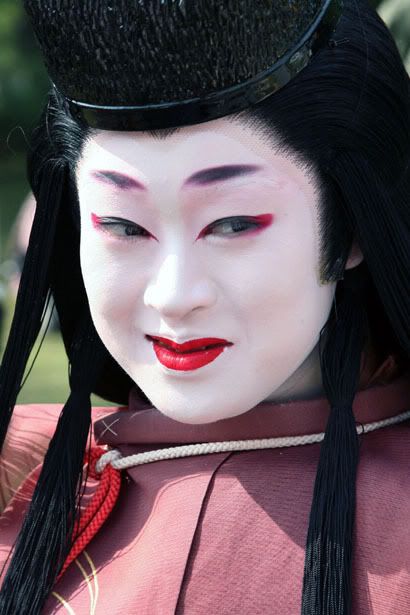 Jidai Matsuri, Kyoto`s Festival of Ages, started as a way to revitalize Kyoto after Japan's capitol moved to Tokyo. It has now grown to include over two thousand participants (Kyoto residents, including Maiko and Geiko) dressed in authentic period costumes from throughout Japan`s history valued at over $25 million.
Jidai Matsuri, Kyoto`s Festival of Ages, started as a way to revitalize Kyoto after Japan's capitol moved to Tokyo. It has now grown to include over two thousand participants (Kyoto residents, including Maiko and Geiko) dressed in authentic period costumes from throughout Japan`s history valued at over $25 million.Izumo-no-Okuni (1600), the mother of Kabuki, was once a maiden in the service of the Izumo Shrine, one of Japan’s holiest Shinto shrines. She later became famous for her dancing, and legend holds that her troup`s first performance took place in the dry bed of the Kamo River. These dances were very popular (I have been told the originall characters used to write kabuki meant song, dance and prostitution), so popular that the Tokugawa shogunate banned women from the stage. From then on, all roles have been placed by men. Today Kabuki is written with characters meaning song, dance and skill.

Lady Shizuka (played by Masayo, a high ranking maiko from Gion Higashi), a famed Kyoto dancer of the late 12th century,was the lover of the hero Minamoto-no-Yoshitsune, a brilliant Genji general in the Gempei War (1180-1185). His success, however, earned him the distrust of his half-brother, Yoritomo, the leader of the Genji (vs. the Heike). In 1185, Yoritomo forced his half-brother to flee and live like an outlaw.
Four years later, facing capture and certain execution, Yoshitsune committed suicide. Shizuka, pregnant with his child, was captured by Yoritomo. Reportedly, she danced for him and so charmed him that Yoritomo spared her life and that of her unborn child only if it was a girl. Unfortunately, a son was born and soon killed to prevent him from seeking vengeance for his father's death later in life.
Tidak ada komentar:
Posting Komentar